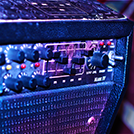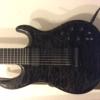Leaderboard
Popular Content
Showing content with the highest reputation on 12/26/2018 in all areas
-
I debated whether to post this or not. Bottom line, I'd want to know. So here's a quote from Digital Igloo posted today at TGP. Finishing up Helix Core has been a slog. We have models for 2.80 finished (and more to come) but haven't even started on user-facing features, as we'd have to code everything twice (once for Helix Core SKUs, again for those that don't aren't yet fully Core). There'll probably be a preview at NAMM but it won't be ready until later. My personal pet feature made it in. Finally.2 points
-
I've got the rack unit, and Logic X. Plan to do some recording, so your post caught my eye. Unless there is some kind of problem with any of the components - seems when you arm to record, Logic is sending a MIDI message back to the Helix. Since it's flashing the tuner, it should be CC#68 in there somewhere - the reserved number for the tuner on the Helix. Since I'm not sure how to disarm outgoing MIDI messages on Logic (I'm sure it's buried in there somewhere), I think the first thing I would try is to turn off the Helix ability to receive MIDI messages via USB (Global Setting - MIDI over USB). If that solves the problem - depending upon your needs, maybe you want other MIDI messages from Logic to Helix - I would then do the research into turning off, or controlling MIDI messages from Logic. Just a first thought, please post what you discover so I'll know what to do when/if it occurs for me. Edit: I did some investigation - Logic has deep/wide MIDI activities going on, far more than I had thought. I think initially shutting off Helix receiving them will tell the initial story. Finding out the specific culprit in Logic - good luck with all that!2 points
-
I went through TGP and got all of the info about the Helix models I could find along with some "hints" and put it in a word document for myself. I wish there was some kind of official Line 6 document with this kind of info in it. Here it is if you want to look at it. It's not really organized all that well but, hey, I created it for me. It's 40 pages long. I had to split it into two documents to attach here. It is in the old Word format. Helix Models Info 1.doc Helix Models Info 2.doc2 points
-
Hello all, I just ordered a Helix and it should arrive tomorrow. In preparation, I found a complete listing of the Helix blocks at dshowmusic. I made the screen shots into a searchable PDF that others might find useful. It seems up to date through firmware 2.60. Included are: Gtr Amps 60 Bass Amps 13 Cabinets 37 FX Distortion 24 FX Dynamics 8 FX EQ 5 FX Modulation 24 FX Delay 18 FX Reverb 17 FX Pitch/Synth 7 FX Filter 3 FX Vol/Pan 4 FX Wah 10 FX legacy ~80 Mics 16 Total 326 Helix Models explained SEARCHABLE.pdf1 point
-
You have latency issues because you're using ASIO4ALL. Take an out from the Scarlett to the PV or FBD or whatever. The past is the past. Nobody's going to waste their time figuring that out, especially when there is an easy solution readily at hand. We've all been there! Every so often i rip it all apart and start over with KISS in mind. That said, my current setup is so simple that I can reconfigure it in minutes to duplicate someone's setup for help purposes (as I did at the beginning of this thread), and set it back in minutes. Don't worry about it, we're all a little masochistic here....:-) If you insist, good luck with that! Seriously, dude, I've just described the simplest, most flexible setup you can have with your hardware, and all you need (since you already have VSTs for re-amping) is a signal splitter of some sort (and Native if you prefer to re-amp with Helix sounds). Take a deep breath, delete ASIO4ALL, pull out all the extraneous wires and boxes, and get down to turn on, load up (Reaper), and ROCK OUT! IT CAN BE DONE! I do it every day!1 point
-
I really appreciate your time, I don't use plugins due to latency issues, that's why I send helix direct to Scarlett for monitoring. I use the Helix 1/4 out to go to my Peavey Valveking, For the record I play through my Fender Blues Deluxe Reissue with no effects at all, a good Strat or Tele through that thing and you're done ;) I was advised to use asio4all years ago, maybe that was bad advice, I don't know enough to have an opinion. There is one question nobody can answer. If everything I've done is wrong, why has it worked since April 2017 when I got my Helix? I had a Boss GT100 before that so things were different. I'm sorry if I'm infuriating you all and maybe I'm not explaining myself very well I just want it how it was before. It suited me, I had a back up computer that I could go to with the click of a switch until I had time to sort my music computer out. I work 50 hours a week, 10 hours on my feet a day, and only get an hour or so a night to practise and record my projects for the people at where I learn to critique. Thank you for all your help, I wish I could stay from scratch with lots of advice but my setup has morphed over the years into an abomination of cables and boxes it's a nightmare just to move anything. My laptop is used like a desktop so it's never moved and I use both screens one for Helix edit and one for Reaper. As helix is under the desk it's easier to see which patch or snapshot I'm on while playing. Cheers Phil1 point
-
Now you've introduced ASIO4ALL into the mix. Please re-read my post about the KISS method. Please re-read my post about using Scarlett as ASIO with a splitter or G10. To use a backing track, send the track from the audio output of either your other computer or a smartphone to a pair of inputs on the Scarlett and take those to a track in Reaper. Piece o' cake, I do it all the time. This too!1 point
-
One thing I don't get is why OP is wasting a perfectly good 18i20 by using the Helix as his ASIO Soundcard. Use the Scarlett as the ASIO Soundcard, get an A/B box to split the signal between Helix and Scarlett inputs (recommend an active vs passive)to get a clean track, OR, do what I do. I use a Relay G10 and send the 1/4" to the Helix and the XLR to the Scarlett. If re-amping is a requirement, get NATIVE! His only problem is his insistence on using the Helix as his soundcard. With my setup, I get to use all of the Scarlett inputs (many more than Helix) AND use HX Edit AND re-amp, all at the same time with NO GRIEF EVER!!1 point
-
AS LONG AS YOU USE THE HELIX AS YOUR ASIO IN YOUR DAW THE DAW PLAYBACK WILL COME THRU THE HELIX TO THE SCARLETT BECAUSE HELIX IS YOUR SOUNDCARD AND YOU CAN"T ROUTE THE DAW PLAYBACK DIRECT TO THE FOCUSRITE UNLESS THE FOCUSRITE IS THE SOUNDCARD IN THE DAW!!!! Sorry to shout, but no matter how many times and ways I say this, you keep missing the point! In your configuration, the Scarlett is ONLY a MIXER! You can route streaming audio from the computer to the Scarlett by setting it as the default device in the Windows Sound Panel, in which case: in the Focusrite Control you set Monitor 1-2/Software (DAW) playback to 1-2 And you can route any Scarlett Input to any Scarlett output BUT YOU CAN"T SEND THE OUTPUT OF YOUR DAW DIRECT TO THE SCARLETT UNLESS THE SCARLETT IS SET IN YOUR DAW AS THE ASIO! Even though the Control SW CALLS it SOFTWARE (DAW) Playback, it only plays back from the DAW if the Scarlett is the ASIO in the DAW. You've already got the Scarlett set as the default device in Windows Sound Panel (per your screenshots). The reason the DAW is playing back thru the Helix is because you're using the Helix as your ASIO Soundcard in your DAW!1 point
-
I'm just going with what Gunmetal said and other than what I posted here, there really isn't any other new info. At least as of now.1 point
-
I do not know what it was. Some one mentioned meters but DI said no, it's not that. This was his specific response. Way too obvious (regarding the meters). Helix Core, however, will improve GUI performance so meters are no longer off the table.1 point
-
When troubleshooting complex systems, it's often useful to cut down to bare bones, and add variables from there. You're getting strange and inconsistent results. The manufacturer says "DON"T USE A HUB!" A fellow user with a very similar system that has NO PROBLEMS says "DON"T USE A HUB!" AND you're sending DATA thru a SWITCH? Start by applying KISS theory.1 point
-
Further to this, there is a Global Setting that can change this behavior. "Global Settings > Preferences > Tap Tempo Pitch" By default that is set to "authentic" which copies the behavior from the real pedals and can create some very odd sounds just as the real pedals did. When set to "transparent" the tap tempo can be used WITHOUT the pitch variations and other artifacts.1 point
-
If you are playing something through a delay set to tap, and you tap the tempo in while its still repeating, you'll get some weird glitch/hiccup noises from the delay trails because you're adjusting them as they are playing so speeding up/slowing down will change pitch and introduce other artifacts.1 point
-
Based on what you are saying, this preset is just running a parallel cab/mic. The signal spits before the top cab.... BOTH CABS get hit with the signal, then the path merges back (blends) with the original. It is fairly common to run to different cabinets at one time... or two of the same cabinets with a different mic/position on them. Visualize this as two cabinets sitting beside each other. You are running out of DSP power. It's not a limit of the path/line itself. The same restrictions will apply if you try to add an effect to the top or bottom line.1 point
-
The only time I use this setup is in a Live setting... I always go direct to the PA/FOH. I setup my patches on my studio monitors (2 sets) at relatively loud volume....and they translate well to the PA, Monitors, and this little pseudo FRFR I put together. Sometimes I need this setup to fill a small room (legion gigs in particular) and it does a great job, but on most gigs it only supplements what I hear through my monitor mix, and fools the musician snobs into thinking I'm playing through an amp :) I'd love a L6 Powercab... but even the regular one is $800 here in Canada. I also don't think I would use the speakers models.. I'd just set it to full range and use the cab modeling or IR's from the Helix. That is sort of what I put together with my little setup.1 point
-
1 point
-
Just because something is old doesn't make it bad. For example the Tube Screamer is still one of the most popular overdrive pedals and it's been out for decades. The PODHD is still and will always be a very good product. It just won't be updated anymore. With that said, I would personally be looking at the Helix LT. I know it's twice the price but it sounds better and is much easier to use. If that's just plain out of your budget then the PODHD is still a very good product.1 point
-
1 point
-
This isn't exactly what you're asking for but. @thenickhill81 has a fantastic demo of a Dimebag rhythm tone where he goes in depth talking about it: If you're really dedicated to matching his lead tone... Research the gear he used in studio: amp, cab, recording mic, etc. There are plenty of impulse responses that you can find online (probably not free) that will replicate what Dimebag was using to create his lead tones in studio. This will get you close to his sound. Its a lot of work. Best of luck.1 point
-
Just wanted to update that I’d gone and got myself a new cable and the situation has improved significantly. Must have had a faulty one earlier.1 point
-
When I search for it I have to use Windows 7 for OS to get it. Using Windows 10 will not find it, maybe Windows 8 would work but ​​I just use Windows 7 'cause it works. Here's a link to the direct download of Gearbox > http://line6.com/software/readeula.html?rid=3121.1 point
This leaderboard is set to Indiana - Indianapolis/GMT-04:00




